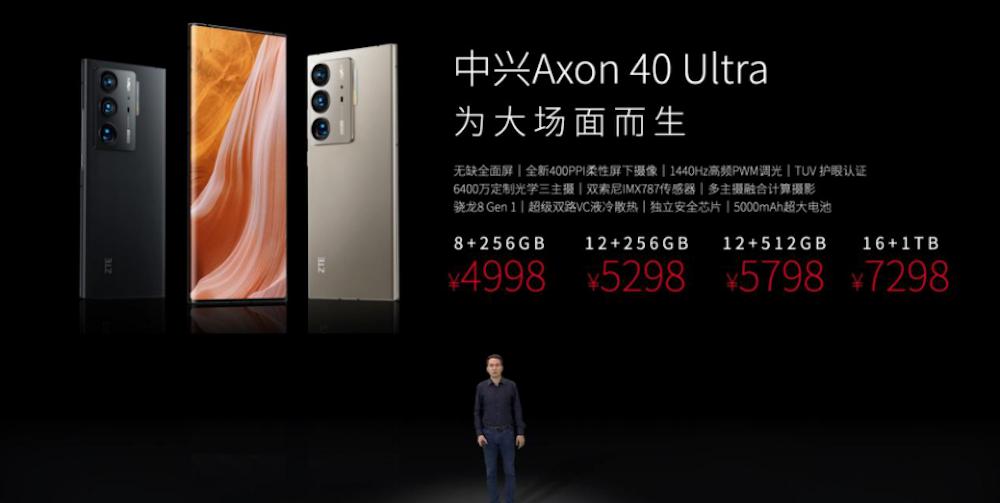Zhi DongXi (public number: zhidxcom)
Author | Xu Shan
Edit | Desert Shadow
On May 9, ZTE Mobile officially released a new generation of ZTE Axon 40 Ultra, which is equipped with the latest ZTE under-screen camera technology.
ZTE Axon 40 Ultra is equipped with a Snapdragon 8 processor, has a 6.8-inch AMOLED screen, and is equipped with a 16 million pixel front-facing camera, and its main camera also supports 8k ultra-high-definition recording, with ink and Dunhuang two color matching options.
At the same time, ZTE also released the Axon 40 Pro. The device adopts Qualcomm Snapdragon 870 processor, equipped with a 100 million pixel main camera and 6.67-inch AMOLED flexible curved screen, and provides three colors: night black, crystal fog blue, and star orange.
ZTE Axon 40 Ultra 8GB+256G version is priced at 4998 yuan, the 12G+256G version is priced at 5298 yuan, the 12G+512G version is priced at 5798 yuan, and the 16G+1T version is priced at 7298 yuan.
The ZTE Axon 40 Pro 8G+256G version is priced at 2998 yuan, the 12G+256G version is priced at 3298 yuan, and the 12G+512G version is priced at 3798 yuan.

First, equipped with Snapdragon 8 processor, ZTE Axon 40 Ultra has a heat dissipation area of 36356mm2
The ZTE Axon 40 Ultra is equipped with the Snapdragon 8+UFS3.1+ full-blood LNDDR5 flagship configuration. ZTE also built a nine-layer heat dissipation architecture, with a total heat dissipation area of up to 36356mm2.
Not only that, ZTE Axon 40 Ultra also has an aerospace-grade micro-nano cavity graphene phase change temperature equalizer plate, which can increase heat absorption performance by 140% and thermal conductivity by 300 times, helping mobile phones to dissipate heat at a high speed and maintain high performance operation.
The ZTE Axon 40 Ultra also comes with a 5000mAh battery and an 80W super fast charge. In the face of different life application scenarios, the ZTE Axon 40 Ultra is also optimized in detail. For example, in the field of sound, the ZTE Axon 40 Ultra is equipped with Snapdragon Sound and DTS sound stereo dual speakers, X-axis linear motors, and high frame rates of 90-120.
At the same time, the ZTE Axon 40 Ultra is also equipped with lane-level high-precision navigation support L1+L5 dual-frequency positioning, which can accurately identify the current lane. In addition, this phone is also equipped with an infrared remote control, equipped with an infrared code library, supporting a photo recognition remote control, which can complete fast pairing.
The second and third main cameras have been fully upgraded to achieve 5.7 times zoom
The ZTE Axon 40 Ultra's triple camera configuration has been fully upgraded, with a 64-megapixel ultra-humanistic main camera, a 64-megapixel ultra-wide-angle main camera, and a 64-megapixel periscope telephoto main camera.
Among them, the humanistic main camera adopts a 35mm equivalent focal length, equipped with a 7P lens, matching the f/1.6 large aperture, and its optical bokeh effect is greatly improved. The wide-angle main camera adopts 16mm equivalent focal length, 4cmAF macro, wide-angle macro two-in-one, and the telephoto main camera adopts 91mm equivalent focal length. According to reports, from wide angle to telephoto can achieve 5.7 times optical zoom.
In terms of algorithms, the ZTE Axon 40 Ultra also has some new breakthroughs.
The unique AI video super-quality algorithm can improve screen brightness, enhance the resolution of dark areas, dynamic range, and reduce noise. ZTE Axon 40 Ultra also creates a smart moon, starry sky enhancement, AI constellation and other starry sky photography gameplay, and provides a wealth of humanistic filters such as Bresson Master black and white filters and film filters, so that users can enjoy the joy of photography.
Third, the original pixel one-drive one technology, under-screen camera technology upgrades
The ZTE Axon 40 Ultra has a screen of 1116×2480 resolution, supports 120Hz intelligent high refresh rate, 360Hz touch sampling rate. Not only that, the screen also adopts independent pixel one-drive one-drive technology, and each pixel unit is driven by a separate pixel circuit, which can make the screen display clearer.
The ZTE Axon 40 Ultra is also equipped with a 16-megapixel front-facing camera, which can reach 2.24μm to blend large pixel effects, bringing greater light sensitivity to the under-screen camera area. The screen in the under-screen camera area adopts a high pixel density of 400PPI, and the full-screen blue diamond arrangement is arranged. In order to eliminate the aggregation of the edge circuit in the off-screen area, the circuit in this area selects the distributed transparent routing scheme under the screen to make the picture transition more natural.
Not only that, the UDC Pro screen display chip has been upgraded, and researchers have upgraded the MRC algorithm and intelligent pixel enhancement and intelligent display optimization technology to make the screen display more accurate and reduce the delay.
Conclusion: "Off-screen camera" technology or into the new key to mobile phone videography
From the ZTE A20 in 2019 to today's ZTE AXON 40 Ultra, ZTE's under-screen camera technology is constantly being updated and iterated. ZTE is forging a new path of its own in off-screen camera technology.
Now, the smart phone market dividend gradually peaked, the difference between mobile phones is getting smaller and smaller, mobile phone manufacturers are trying to play their own brand characteristics, ZTE can rely on the screen camera technology to kill a piece of its own market, wait and see.